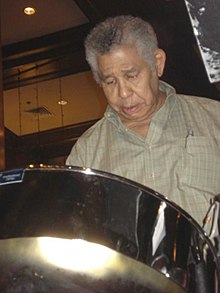Elliot Mannette
Elliot "Ellie" Mannette (born November 5, 1927 in San Souci, Trinidad and Tobago ; † August 29, 2018 in West Virginia , USA) was an instrument maker and musician on the Steel Pan . He is also known as the "father of the modern steel pan".
Life
Mannette developed a passion for metal and tools for metalworking and occupied himself with the development of the phenomenon of the sounding sheet, discovered at that time. From the mid-1930s a competition of percussion orchestras took place in Port of Spain . Allegedly, Mannette was the first person to use a 216-liter oil drum to make a steel pan .
In 1951 the TASPO (Trinidad All Steel Percussion Orchestra) traveled to England to present the new musical instrument at the Festival of Britain . Mannette was a member of this orchestra, which was made up of leaders from various steel bands from Trinidad. During this visit to England Mannette was offered a scholarship to study music in London . He did not accept the offer and traveled home to continue building steel pans. After building the US Navy steel band in the early 1960s , he was invited to New York in 1967 to make steel pans for the city's youth projects. That invitation came from Murray Narell, a New York social worker and father of panplayers Jeff and Andy Narell . Since Mannette has only tuned his instruments with the help of his hearing from the beginning, he was made aware of the need for concert tuning (A, 440 Hz ) by a music teacher from the New York area. Since 1967 Mannette has built around 300 steel bands in the USA, mainly in educational institutions. In 1991 he was invited to the University of West Virginia to introduce students to the Steel Pan instrument. From a guest semester - as was initially planned - the University Tuning Project emerged, during which Mannette began to pass on his knowledge to students.
One of his quotes is: “When I look back more than half a century - at my humble beginnings - no one suspected the rapid development the Steel Pan would make. While I was constantly advancing my skills in pan building, my focus was always on sharing my knowledge with others in order to ensure the progress of this instrument. "
plant
Several innovations are attributed to Mannette that turned out to be essential for the development of the Steel Pan. He was the first to use an oil drum instead of bisque tins or the like to build a steel pan. In addition, it was Mannette who gave the surface of the barrel a concave shape by means of driving work. This enabled the various sounds to be more independent. A pan builder now had more space to shape the notes on the playing surface. Mannette developed several instruments in the Pan family. In particular, his application of the full-tone scale in steel pans with two resonance bodies is still used today.
Mannette developed his personal style over the years. As part of the University Tuning Project at the University of West Virginia in Morgantown, USA, he passed on his system of pan building and pantuning to his students, thereby ensuring that future generations would retain his knowledge. His instruments can be admired in many museums and galleries, including the Smithsonian Institute , the Metropolitan Museum of Art in New York and the Contemporary Art Gallery.
In 1969 Mannette received the Hummingbird Medal Silver from Trinidad and Tobago for his innovations in pan building. In 1999 Mannette received the National Endowment for the Arts Award at the White House . In 2000 he was awarded an honorary doctorate from the University of the West Indies in Trinidad , and in the same year he received the Chaconia Medal Silver of his home country for his work. In 2003 Mannette was inducted into the Hall of Fame of the US Percussive Arts Society.
Web links
Individual evidence
- ↑ Ronald C. Emrit: Elliot Mannette. In: Bestoftrinidad.com. Retrieved August 30, 2018 .
- ↑ Ellie Mannette speaks. (2:04 minutes) Video on YouTube , October 18, 2008, accessed August 30, 2018 (English).
- ^ Father of the US Navy Steel Band. Military.com , November 12, 2000, archived from the original on May 1, 2005 ; accessed on August 30, 2018 (English).
- ↑ ToothillSchool.co.uk: A Brief History: Origins of the Steel Drum and Rhythmical Steel. Retrieved January 10, 2020 . (PDF, 78 kB)
- ↑ Angela Smith: Steel Drums and Steelbands: A History . Scarecrow Press, London 2012, ISBN 978-0-8108-8343-7 , pp. 128 .
- ↑ Norman Darway: The Early Beginnings of the steelpan - The Untold Story. We cannot forget Ellie Mannette. In: Trinbagopan.com. March 1, 2005, accessed August 30, 2018 .
- ^ NEA National Heritage Fellowships: Elliott “Ellie” Mannette. In: National Endowment for the Arts . August 19, 2013, accessed July 23, 2015 .
- ↑ Lisa Rogers: Elliott "Ellie" Mannette. In: Website of the Percussive Arts Society. Archived from the original on January 10, 2015 ; accessed on July 23, 2015 .
| personal data | |
|---|---|
| SURNAME | Mannette, Elliot |
| ALTERNATIVE NAMES | Mannette, Ellie (nickname) |
| BRIEF DESCRIPTION | Trinidadian steel pan musician |
| DATE OF BIRTH | November 5, 1927 |
| PLACE OF BIRTH | San Souci, Trinidad and Tobago |
| DATE OF DEATH | 29th August 2018 |
| Place of death | West Virginia |
